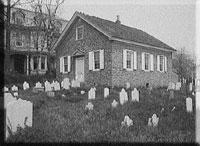Related Topics
To Germantown, a Short Appreciation
Seven miles from the heart of Philadelphia, Germantown was once a separate town, the cultural center of Germans in America. Revolutionary battles were fought here, it was briefly the capital of the United States, and it still has an outstanding collection of schools and colleges.
Particular Sights to See:Center City
Taxi drivers tell tourists that Center City is a "shining city on a hill". During the Industrial Era, the city almost urbanized out to the county line, and then retreated. Right now, the urban center is surrounded by a semi-deserted ring of former factories.
Touring Philadelphia's Western Regions
Philadelpia County had two hundred farms in 1950, but is now thickly settled in all directions. Western regions along the Schuylkill are still spread out somewhat; with many historic estates.
The Main Line
Like all cities, Philadelphia is filling in and choking up with subdivisions and development, in all directions from the center. The last place to fill up is the Welsh Barony, a tip of which can be said to extend all the way in town to the Art Museum.
Chapter Six: Constitutions: What's So Good About Ours; Why Does Europe's Fail Them?1793-70
Germantown After 1730

|
| German Quaker Home |
The early settlers of Germantown were Dutch or German-speaking Quakers. They were proud of the craftsman class but, unfortunately, that made them rather poor subsistence farmers. With a whole continent stretching beyond them, professional farmers would not likely choose to settle on a stony hilltop, two hours away from Philadelphia. Germantown's future lay in religious congregation, in papermaking, textile manufacture, publishing, printing and newspapers. Plenty of stones were lying around, so stone houses soon replaced the early wooden ones. Since Philadelphia in 1776 had only twenty or so thousand inhabitants, and only thirty wheeled vehicles other than wagons, it was not too difficult for Germantown to imagine it might eventually eclipse that nearby seaport full of Englishmen. Two wars and two epidemics brought those Germantown dreams to an end, but in a sense, those calamities were stimulants to the town, as well.
In 1730 real German peasants began to arrive in large numbers from the Palatinate section of the Rhine Valley. They arrived as survivors of a horrendous ocean sailing experience, packed in such density that it was not unusual to find dead bodies in the hold, of passengers that had only been supposed to have wandered into a different part of the ship. Quite often, they paid for their passage by selling themselves into what amounted to limited-time slavery, and a customary pattern was for parents to sell an adolescent child into slavery for eight or ten years in order to pay for the voyage of the family. They were uneducated, even ignorant, and often were proponents of small new religious sects. All of that made them seem to be a primitive tribe in the eyes of the earlier settlers. But they were professional farmers, and good at it. They knew, and a quick tour of Lancaster County today confirms their belief, that if you had a reasonable amount of very good land, you could live a life that approached that of the craftsmen in comfort, and usually far exceeded them in personal assets. They have therefore taken a long time to rise from farm to sophistication, while the already sophisticated craftsmen in Germantown wasted no time in abandoning farming. The peasant newcomers arrived in Philadelphia, made their way to nearby Germantown, learned a little about the new country and the refinements of their Protestant culture -- and then pressed on to the great fertile valley to the West, where the way had been paved by those twenty-five German families who had landed on the Hudson River several decades earlier and come down the Susquehanna via Cooperstown. Only a minority of the after-1730 Germans stayed on permanently in that steadily growing little German metropolis on a hill, and none of the very earliest German pioneers further west had even landed in Philadelphia.
During this period, this Athens of German America also invented the Suburb. The pioneer of this concept was Benjamin Chew, the Chief Justice, who built a magnificent stone mansion on Germantown Avenue, which was to become the main fortress of the Battle of Germantown in the Revolutionary War. Present-day visitors are still impressed with the immensity and sturdy mass of this home. Grumblethorpe, Stenton and a score of other country homes were placed there. Germantown in 1750 still wasn't a very big town, but it was plenty comfortable, quiet, safe, intellectual and affluent. Its first disruption came from the French and Indian War.
Originally published: Friday, June 23, 2006; most-recently modified: Wednesday, May 22, 2019
| Posted by: Bernie | Dec 11, 2018 9:28 PM |
| Posted by: cheapoair promo code | Feb 13, 2012 9:40 AM |
| Posted by: esalerugs coupons | Feb 13, 2012 9:18 AM |